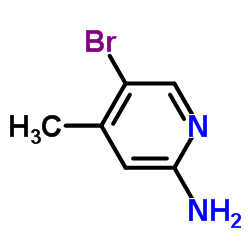1,2-双(2S,5S)-二乙基环丁膦烷苯(环辛二烯)铑三氟甲磺酸盐, 99%,1,2-Bis[(2S,5S)-2,5-diethylphospholano]benzene(1,5-cyclooctadiene)rhodium(I) trifluoromethanesulfonat
产品编号:西域试剂-WR363979| CAS NO:142184-30-3| MDL NO:MFCD00269861| 分子式:C31H48F3O3P2RhS| 分子量:722.635
本网站销售的所有产品仅用于工业应用或者科学研究等非医疗目的,不可用于人类或动物的临床诊断或者治疗,非药用,非食用,
| 英文名称 | 1,2-Bis[(2S,5S)-2,5-diethylphospholano]benzene(1,5-cyclooctadiene)rhodium(I) trifluoromethanesulfonat |
|---|---|
| CAS编号 | 142184-30-3 |
| 产品沸点 | 254.2±35.0 °C at 760 mmHg |
| 产品密度 | 1.6±0.1 g/cm3 |
| 产品闪点 | 107.5±25.9 °C |
| 精确质量 | 185.979248 |
| PSA | 39.64000 |
| LogP | 2.44 |
| 蒸气压 | 0.0±0.5 mmHg at 25°C |
| 折射率 | 1.617 |
| 稳定性 | 如果遵照规格使用和储存则不会分解,未有已知危险反应 避免氧化物 |
| 储存条件 | 密封,在4ºC下保存 |
相关文档
化学品安全说明书(MSDS)
下载MSDS质检证书(COA)
相关产品
| 符号 |

GHS07 |
|---|---|
| 信号词 | Warning |
| 危害声明 | H315-H319-H335 |
| 警示性声明 | P261-P305 + P351 + P338 |
| 个人防护装备 | dust mask type N95 (US);Eyeshields;Gloves |
| 危害码 (欧洲) | Xi |
| 风险声明 (欧洲) | 36/37/38 |
| 安全声明 (欧洲) | S24/25 |
| 危险品运输编码 | NONH for all modes of transport |
|
Section 1: Product Identification (+)-1,2-Bis((2S,5S)-2,5-diethylphospholano)benzene(1,5-cyclooctadiene)rhodium (I) Chemical Name: trifluoromethanesulfonate, 98+% (S,S)-Et-DUPHOS-Rh CAS Registry Number:142184-30-3 Formula:Rh(C8H12)(C22H36P2)+ CF3SO3- EINECS Number:none
Chemical Family:organometallic complex Synonym:none Section 2: Composition and Information on Ingredients IngredientCAS NumberPercentACGIH (TWA)OSHA (PEL) Title compound142184-30-3100%2.5mg/m3 (as F)2.5mg/m3 (as F) Section 3: Hazards Identification Emergency Overview:Irritating to skin, eyes and respiratory tract. Primary Routes of Exposure:Ingestion Eye Contact:Causes irritation to the eyes Skin Contact:Causes slight to mild irritation of the skin. Inhalation:Irritating to the nose, mucous membranes and respiratory tract. Ingestion:No information is available on the physiological effects of ingestion. Acute Health Affects:Irritating to skin, eyes and respiratory tract. Chronic Health Affects:No information available on long-term chronic effects. NTP:No IARC:No OSHA:No SECTION 4: First Aid Measures Immediately flush the eyes with copious amounts of water for at least 10-15 minutes. A victim may need Eye Exposure: assistance in keeping their eye lids open. Get immediate medical attention. Wash the affected area with water. Remove contaminated clothes if necessary. Seek medical assistance if Skin Exposure: irritation persists. Remove the victim to fresh air. Closely monitor the victim for signs of respiratory problems, such as difficulty Inhalation: in breathing, coughing, wheezing, or pain. In such cases seek immediate medical assistance. Seek medical attention immediately. Keep the victim calm. Give the victim water (only if conscious). Induce Ingestion: vomiting only if directed by medical personnel. SECTION 5: Fire Fighting Measures Flash Point:none Autoignition Temperature:none Explosion Limits:none Extinguishing Medium:carbon dioxide, dry powder or foam Fire fighters should be equipped with a NIOSH approved positive pressure self-contained breathing apparatus Special Fire Fighting Procedures: and full protective clothing. Hazardous Combustion andIf involved in a fire this material may emit toxic organic fumes. Decomposion Products: Unusual Fire or Explosion Hazards: No unusual fire or explosion hazards. SECTION 6: Accidental Release Measures Spill and Leak Procedures:Small spills can be mixed with vermiculite or sodium carbonate and swept up. SECTION 7: Handling and Storage The material will degrade on prolonged exposure to air. Store cold, under an inert atmosphere of nitrogen or Handling and Storage:argon. Keep bottle tightly sealed and away from heat and direct sunlight. For prolonged storage keep material refrigerated. SECTION 8: Exposure Controls and Personal Protection Eye Protection:Always wear approved safety glasses when handling a chemical substance in the laboratory. Skin Protection:Wear protective clothing and gloves. Ventilation:If possible, handle the material in an efficient fume hood. If ventilation is not available, a respirator should be worn. The use of respirators requires a Respiratory Respirator: Protection program to be in compliance with 29 CFR 1910.134. Ventilation:If possible, handle the material in an efficient fume hood. Additional Protection:No additional protection required. SECTION 9: Physical and Chemical Properties Color and Form:orange xtl. Molecular Weight:722.63 Melting Point:decomposes Boiling Point:decomposes Vapor Pressure:not applicable Specific Gravity:no data Odor:none Solubility in Water:insoluble SECTION 10: Stability and Reactivity Stability:air sensitive (store cold) Hazardous Polymerization:none Conditions to Avoid:contact with air. This material may degrade on prolonged exposure to air and moisture. Incompatibility:strong oxidizing agents Decomposition Products:carbon dioxide, carbon monoxide, phosphorus pentoxide, organic fumes and fluorinated byproducts. SECTION 11: Toxicological Information RTECS Data:No data available Carcinogenic Effects:No data available Mutagenic Effects:No data available Tetratogenic Effects:No data available SECTION 12: Ecological Information Ecological Information:No information available SECTION 13: Disposal Considerations Disposal:Dispose of according to local, state and federal regulations. SECTION 14: Transportation Shipping Name (CFR):Non-hazardous Hazard Class (CFR):NA Additional Hazard Class (CFR):NA Packaging Group (CFR):NA UN ID Number (CFR):NA Shipping Name (IATA):Non-hazardous Hazard Class (IATA):NA Additional Hazard Class (IATA):NA Packaging Group (IATA):NA UN ID Number (IATA):NA SECTION 15: Regulatory Information TSCA:not listed on the TSCA inventory SARA (Title 313):not regulated by Title 313 Second Ingredient:none SECTION 16 - ADDITIONAL INFORMATION N/A |









 浙公网安备 33010802013016号
浙公网安备 33010802013016号